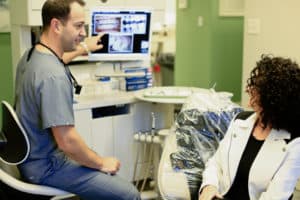May 26, 2015

Dentists have been using x-rays since 1896 to spot decay and bone loss that cannot always be found during a typical routine check-up. Moreover, with the development of digital x-rays, overall dental care has significantly improved. Digital technology is now allowing dentists to take x-rays with less radiation, faster result times, higher quality images, and easier record-keeping. Dr. Petry and Dr. Walton have invested time, money and support into digital x-ray technology to improve the safety and care of their patients.
Read more to find out how digital x-ray imaging is different than traditional film radiology, and how it helps you as a dental patient.
What Are Digital X-Rays?
Digital radiography is very similar to a digital camera. Instead of using film that needs to be developed, the digital x-ray machine uses sensors that receive the x-rays and then transmits them to your dentist’s computer.
Digital x-ray machines still use x-rays, which is an electromagnetic radiation like light, microwaves and radio. The X-rays’ short wavelengths allow them to pass through skin and most tissue. The calcium in bones and teeth then absorb the x-rays, making them visible as the lighter parts of the x-ray image.
Your dentist can use the images to see how your teeth line up, how deep cavities are, and if there is any decay or bone loss under the gum line or between teeth. Digital x-rays are much easier to store, and the quick chair-side retrieval allows your dentist to see how things are progressing from one visit to the next in a very timely manner.
How are Digital X-Rays Improving Dental Care?
1. Less radiation per exposure
Many of our patients are concerned with how much radiation they are exposed to when they a dental x-ray is taken. Dental x-rays use a relatively small and safe amount of radiation, and digital x-rays use even less than traditional x-rays – as much as 50 to 80 percent less radiation per image.
2. Faster and cleaner image development
Digital cameras have freed photographers from having to get camera film developed into paper images. Now, your pictures can be seen immediately on your phone or on the back of your digital camera. Selfies and vacation pictures can be up on your social media accounts at the drop of a hat.
The same is true for digital x-rays too – well, except for the social media part. The sensors that replaced the actual x-ray film now send an image directly to your dentist’s computer – rather than having to wait until the appropriate time to develop the film. No more films on the back-lit x-ray boards!
This new technology allows us to zoom in, save and compare the images right away. The images can also be shared with your other oral health providers, like orthodontists for example. In addition, digital x-rays are also safer for our staff members and for the environment.
3. Better resolution and visibility
Digital x-ray images are the equivalent of high definition televisions or higher megapixel counts on your digital cameras. Traditional film x-rays used to be one-size-fits-all. They were developed to the same size every time, which meant that dentists could not see more minuscule detail without another shot.
Digital images, on the other hand, can be zoomed, rotated, contrast-enhanced and easily compared to other images all within the first shot. This translates to faster and more accurate diagnoses and treatment decisions.
Where Can I Get Digital X-Rays in Akron, OH?
Dr. Petry and Dr. Waltron use this simple, safe and non-invasive approach of assessing the overall health of your teeth, jaw and surrounding tissue. Contact us today for an appointment.


